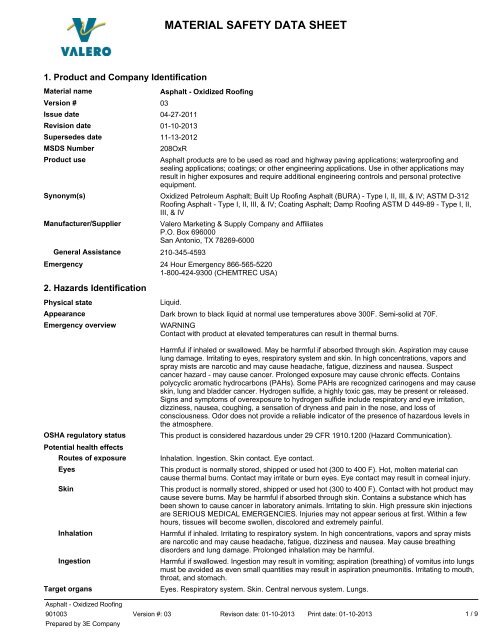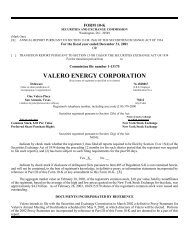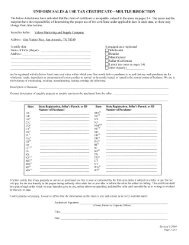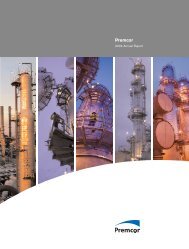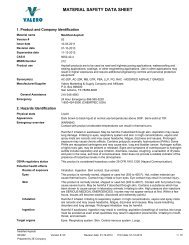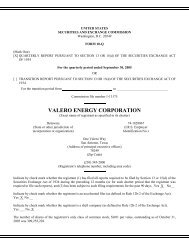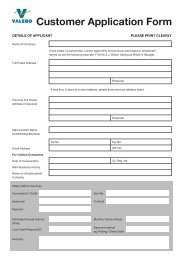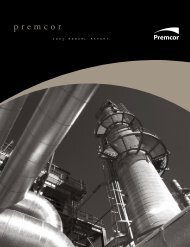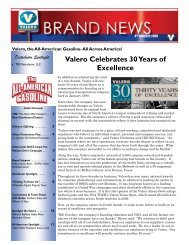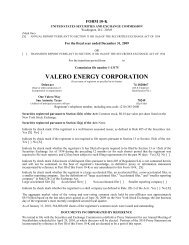Asphalt - Oxidized Roofing - 208OxR - Valero
Asphalt - Oxidized Roofing - 208OxR - Valero
Asphalt - Oxidized Roofing - 208OxR - Valero
Create successful ePaper yourself
Turn your PDF publications into a flip-book with our unique Google optimized e-Paper software.
MATERIAL SAFETY DATA SHEET<br />
1. Product and Company Identification<br />
Material name<br />
Version # 03<br />
Issue date 04-27-2011<br />
Revision date 01-10-2013<br />
Supersedes date 11-13-2012<br />
MSDS Number<br />
Product use<br />
<strong>Asphalt</strong> - <strong>Oxidized</strong> <strong>Roofing</strong><br />
<strong>208OxR</strong><br />
<strong>Asphalt</strong> products are to be used as road and highway paving applications; waterproofing and<br />
sealing applications; coatings; or other engineering applications. Use in other applications may<br />
result in higher exposures and require additional engineering controls and personal protective<br />
equipment.<br />
Synonym(s) <strong>Oxidized</strong> Petroleum <strong>Asphalt</strong>; Built Up <strong>Roofing</strong> <strong>Asphalt</strong> (BURA) - Type I, II, III, & IV; ASTM D-312<br />
<strong>Roofing</strong> <strong>Asphalt</strong> - Type I, II, III, & IV; Coating <strong>Asphalt</strong>; Damp <strong>Roofing</strong> ASTM D 449-89 - Type I, II,<br />
III, & IV<br />
Manufacturer/Supplier<br />
General Assistance<br />
<strong>Valero</strong> Marketing & Supply Company and Affiliates<br />
P.O. Box 696000<br />
San Antonio, TX 78269-6000<br />
210-345-4593<br />
Emergency 24 Hour Emergency 866-565-5220<br />
1-800-424-9300 (CHEMTREC USA)<br />
2. Hazards Identification<br />
Physical state<br />
Liquid.<br />
Appearance Dark brown to black liquid at normal use temperatures above 300F. Semi-solid at 70F.<br />
Emergency overview<br />
WARNING<br />
Contact with product at elevated temperatures can result in thermal burns.<br />
OSHA regulatory status<br />
Potential health effects<br />
Routes of exposure<br />
Eyes<br />
Skin<br />
Inhalation<br />
Ingestion<br />
Target organs<br />
Harmful if inhaled or swallowed. May be harmful if absorbed through skin. Aspiration may cause<br />
lung damage. Irritating to eyes, respiratory system and skin. In high concentrations, vapors and<br />
spray mists are narcotic and may cause headache, fatigue, dizziness and nausea. Suspect<br />
cancer hazard - may cause cancer. Prolonged exposure may cause chronic effects. Contains<br />
polycyclic aromatic hydrocarbons (PAHs). Some PAHs are recognized carinogens and may cause<br />
skin, lung and bladder cancer. Hydrogen sulfide, a highly toxic gas, may be present or released.<br />
Signs and symptoms of overexposure to hydrogen sulfide include respiratory and eye irritation,<br />
dizziness, nausea, coughing, a sensation of dryness and pain in the nose, and loss of<br />
consciousness. Odor does not provide a reliable indicator of the presence of hazardous levels in<br />
the atmosphere.<br />
This product is considered hazardous under 29 CFR 1910.1200 (Hazard Communication).<br />
Inhalation. Ingestion. Skin contact. Eye contact.<br />
This product is normally stored, shipped or used hot (300 to 400 F). Hot, molten material can<br />
cause thermal burns. Contact may irritate or burn eyes. Eye contact may result in corneal injury.<br />
This product is normally stored, shipped or used hot (300 to 400 F). Contact with hot product may<br />
cause severe burns. May be harmful if absorbed through skin. Contains a substance which has<br />
been shown to cause cancer in laboratory animals. Irritating to skin. High pressure skin injections<br />
are SERIOUS MEDICAL EMERGENCIES. Injuries may not appear serious at first. Within a few<br />
hours, tissues will become swollen, discolored and extremely painful.<br />
Harmful if inhaled. Irritating to respiratory system. In high concentrations, vapors and spray mists<br />
are narcotic and may cause headache, fatigue, dizziness and nausea. May cause breathing<br />
disorders and lung damage. Prolonged inhalation may be harmful.<br />
Harmful if swallowed. Ingestion may result in vomiting; aspiration (breathing) of vomitus into lungs<br />
must be avoided as even small quantities may result in aspiration pneumonitis. Irritating to mouth,<br />
throat, and stomach.<br />
Eyes. Respiratory system. Skin. Central nervous system. Lungs.<br />
<strong>Asphalt</strong> - <strong>Oxidized</strong> <strong>Roofing</strong><br />
901003<br />
Version #: 03<br />
Revison date: 01-10-2013 Print date: 01-10-2013<br />
CPH MSDS NA<br />
1 / 9<br />
Prepared by 3E Company
Chronic effects<br />
Signs and symptoms<br />
Potential environmental effects<br />
Suspect cancer hazard - may cause cancer. May cause central nervous system disorder (e.g.,<br />
narcosis involving a loss of coordination, weakness, fatigue, mental confusion and blurred vision)<br />
and/or damage. Frequent or prolonged contact may defat and dry the skin, leading to discomfort<br />
and dermatitis.<br />
Irritation of nose and throat. Irritation of eyes and mucous membranes. Skin irritation.<br />
Unconsciousness. Corneal damage. Narcosis. Decrease in motor functions. Behavioral changes.<br />
Edema. Conjunctivitis. Proteinuria. Defatting of the skin. Rash.<br />
The product is not expected to be hazardous to the environment.<br />
3. Composition / Information on Ingredients<br />
Components CAS # Percent<br />
<strong>Asphalt</strong><br />
<strong>Asphalt</strong>, oxidized<br />
Vaccum Tower Bottoms<br />
Distillates, petroleum residues, vaccum<br />
Hydrogen sulfide<br />
Polycyclic Aromatic Hydrocarbons<br />
8052-42-4 0 - 100<br />
64742-93-4 0 - 100<br />
64741-56-6 0 - 100<br />
68955-27-1 0 - 15<br />
7783-06-4
Specific methods<br />
Hazardous combustion<br />
products<br />
6. Accidental Release Measures<br />
Personal precautions<br />
Environmental precautions<br />
Methods for containment<br />
Methods for cleaning up<br />
Other information<br />
7. Handling and Storage<br />
Handling<br />
Storage<br />
In the event of fire and/or explosion do not breathe fumes.<br />
Carbon monoxide. Carbon Dioxide. Sulfur oxides. Nitrogen oxides (NOx). Hydrocarbons.<br />
Hydrogen sulfide.<br />
Keep unnecessary personnel away. Local authorities should be advised if significant spills cannot<br />
be contained. Keep upwind. Keep out of low areas. Ventilate closed spaces before entering. Do<br />
not touch damaged containers or spilled material unless wearing appropriate protective clothing.<br />
See Section 8 of the MSDS for Personal Protective Equipment.<br />
If facility or operation has an "oil or hazardous substance contingency plan", activate its<br />
procedures. Stay upwind and away from spill. Wear appropriate protective equipment including<br />
respiratory protection as conditions warrant. Do not enter or stay in area unless monitoring<br />
indicates that it is safe to do so. Isolate hazard area and restrict entry to emergency crew. Review<br />
Firefighting Measures, Section 5, before proceeding with clean up. Keep all sources of ignition<br />
(flames, smoking, flares, etc.) and hot surfaces away from release. Contain spill in smallest<br />
possible area. Recover as much product as possible (e.g. by vacuuming). Stop leak if it can be<br />
done without risk. Use water spray to disperse vapors. Use compatible foam to minimize vapor<br />
generation as needed. Spilled material may be absorbed by an appropriate absorbent, and then<br />
handled in accordance with environmental regulations. Prevent spilled material from entering<br />
sewers, storm drains, other unauthorized treatment or drainage systems and natural waterways.<br />
Contact fire authorities and appropriate federal, state and local agencies. If spill of any amount is<br />
made into or upon navigable waters, the contiguous zone, or adjoining shorelines, contact the<br />
National Response Center at 1-800-424-8802. For highway or railways spills, contact Chemtrec at<br />
1-800-424-9300.<br />
Eliminate all ignition sources (no smoking, flares, sparks, or flames in immediate area). Local<br />
authorities should be advised if significant spillages cannot be contained. Stop leak if you can do<br />
so without risk. Dike the spilled material, where this is possible. Prevent entry into waterways,<br />
sewers, basements or confined areas.<br />
Use only non-sparking tools.<br />
8. Exposure Controls / Personal Protection<br />
Occupational exposure limits<br />
US. ACGIH Threshold Limit Values<br />
Large Spills: Prevent product from entering drains.<br />
Clean up in accordance with all applicable regulations.<br />
Wear personal protective equipment. Avoid breathing mist or vapor from heated material. Avoid<br />
contact with eyes, skin, and clothing. Avoid prolonged exposure. Use only with adequate<br />
ventilation. Wash thoroughly after handling. Do not handle, store or open near an open flame or<br />
sources of ignition. Protect material from direct sunlight. Take precautionary measures against<br />
static discharges. All equipment used when handling the product must be grounded. Use only<br />
non-sparking tools. When using, do not eat, drink or smoke. Avoid release to the environment.<br />
Material is normally stored in closed tanks at 250 to 375F. Do not handle, store or open near an<br />
open flame or sources of ignition. Protect material from direct sunlight. This material can<br />
accumulate static charge which may cause spark and become an ignition source. The pressure in<br />
sealed containers can increase under the influence of heat. Keep container tightly closed in a<br />
cool, well-ventilated place. Keep away from food, drink and animal feedingstuffs. Keep out of the<br />
reach of children.<br />
Components<br />
<strong>Asphalt</strong> (CAS 8052-42-4)<br />
Hydrogen sulfide (CAS<br />
7783-06-4)<br />
Vaccum Tower Bottoms<br />
(CAS 64741-56-6)<br />
US. OSHA Table Z-2 (29 CFR 1910.1000)<br />
Type<br />
Value<br />
Form<br />
TWA 0.5 mg/m3 Inhalable fraction.<br />
STEL<br />
5 ppm<br />
TWA<br />
1 ppm<br />
TWA 0.5 mg/m3 Inhalable fraction.<br />
Components<br />
Hydrogen sulfide (CAS<br />
7783-06-4)<br />
Type<br />
Ceiling<br />
Value<br />
20 ppm<br />
<strong>Asphalt</strong> - <strong>Oxidized</strong> <strong>Roofing</strong><br />
901003<br />
Prepared by 3E Company<br />
Version #: 03<br />
Revison date: 01-10-2013 Print date: 01-10-2013<br />
CPH MSDS NA<br />
3 / 9
Canada. Alberta OELs (Occupational Health & Safety Code, Schedule 1, Table 2)<br />
Components<br />
<strong>Asphalt</strong> (CAS 8052-42-4)<br />
Hydrogen sulfide (CAS<br />
7783-06-4)<br />
Vaccum Tower Bottoms<br />
(CAS 64741-56-6)<br />
Type<br />
Value<br />
Form<br />
TWA 5 mg/m3 Fume.<br />
Ceiling<br />
21 mg/m3<br />
15 ppm<br />
TWA<br />
14 mg/m3<br />
10 ppm<br />
TWA 5 mg/m3 Fume.<br />
Canada. British Columbia OELs. (Occupational Exposure Limits for Chemical Substances, Occupational Health and<br />
Safety Regulation 296/97, as amended)<br />
Components<br />
<strong>Asphalt</strong> (CAS 8052-42-4)<br />
Hydrogen sulfide (CAS<br />
7783-06-4)<br />
Vaccum Tower Bottoms<br />
(CAS 64741-56-6)<br />
Type<br />
Value<br />
Form<br />
TWA 0.5 mg/m3 Aerosol, inhalable.<br />
Ceiling<br />
10 ppm<br />
TWA 0.5 mg/m3 Aerosol, inhalable.<br />
Canada. Ontario OELs. (Control of Exposure to Biological or Chemical Agents)<br />
Components<br />
<strong>Asphalt</strong> (CAS 8052-42-4)<br />
Hydrogen sulfide (CAS<br />
7783-06-4)<br />
Vaccum Tower Bottoms<br />
(CAS 64741-56-6)<br />
Type<br />
Value<br />
Form<br />
TWA 0.5 mg/m3 Inhalable fraction.<br />
STEL<br />
15 ppm<br />
TWA<br />
10 ppm<br />
TWA 0.5 mg/m3 Inhalable fraction.<br />
Canada. Quebec OELs. (Ministry of Labor - Regulation Respecting the Quality of the Work Environment)<br />
Components<br />
<strong>Asphalt</strong> (CAS 8052-42-4)<br />
Hydrogen sulfide (CAS<br />
7783-06-4)<br />
Vaccum Tower Bottoms<br />
(CAS 64741-56-6)<br />
Mexico. Occupational Exposure Limit Values<br />
Type<br />
Value<br />
Form<br />
TWA 5 mg/m3 Fume.<br />
STEL<br />
21 mg/m3<br />
15 ppm<br />
TWA<br />
14 mg/m3<br />
10 ppm<br />
TWA 5 mg/m3 Fume.<br />
Components<br />
<strong>Asphalt</strong> (CAS 8052-42-4)<br />
Hydrogen sulfide (CAS<br />
7783-06-4)<br />
Vaccum Tower Bottoms<br />
(CAS 64741-56-6)<br />
Engineering controls<br />
Personal protective equipment<br />
Eye / face protection<br />
Skin protection<br />
Respiratory protection<br />
Type<br />
Value<br />
Form<br />
STEL 10 mg/m3 Fume.<br />
TWA 5 mg/m3 Fume.<br />
STEL<br />
21 mg/m3<br />
15 ppm<br />
TWA<br />
14 mg/m3<br />
10 ppm<br />
STEL 10 mg/m3 Fume.<br />
TWA 5 mg/m3 Fume.<br />
Provide adequate general and local exhaust ventilation. Use process enclosures, local exhaust<br />
ventilation, or other engineering controls to control airborne levels below recommended exposure<br />
limits.<br />
Wear safety glasses. If splash potential exists, wear full face shield or chemical goggles.<br />
Wear chemical-resistant, impervious gloves. Flame retardant protective clothing is recommended.<br />
Wear a NIOSH-approved (or equivalent) respirator as needed.<br />
<strong>Asphalt</strong> - <strong>Oxidized</strong> <strong>Roofing</strong><br />
901003<br />
Prepared by 3E Company<br />
Version #: 03<br />
Revison date: 01-10-2013 Print date: 01-10-2013<br />
CPH MSDS NA<br />
4 / 9
General hygiene<br />
considerations<br />
9. Physical & Chemical Properties<br />
Consult supervisor for special handling instructions. Avoid contact with eyes. Avoid contact with<br />
skin. Keep away from food and drink. Wash hands before breaks and immediately after handling<br />
the product. Provide eyewash station and safety shower. Handle in accordance with good<br />
industrial hygiene and safety practice.<br />
Appearance Dark brown to black liquid at normal use temperatures above 300F. Semi-solid at 70F.<br />
Physical state<br />
Form<br />
Color<br />
Odor<br />
Odor threshold<br />
pH<br />
Liquid.<br />
Semi-Solid at 70F<br />
Brown/black.<br />
Strong petroleum.<br />
Not available.<br />
Not available.<br />
Vapor pressure < 0.01 kPa @ 20 °C<br />
Vapor density > 1.6 (Air = 1)<br />
Boiling point<br />
Melting point/Freezing point<br />
Solubility (water)<br />
Specific gravity<br />
Flash point<br />
Flammability limits in air,<br />
upper, % by volume<br />
Flammability limits in air,<br />
lower, % by volume<br />
Auto-ignition temperature<br />
Other data<br />
Flash point class<br />
700 - 1100.1 °F (371.1 - 593.4 °C)<br />
150 - 250 °F (65.6 - 121.1 °C) (Softening point)<br />
Not available.<br />
1 - 1.2 (Water=1)<br />
> 350.1 °F (> 176.7 °C) Closed Cup<br />
< 7<br />
> 0.9<br />
> 600.1 °F (> 315.61 °C)<br />
Combustible IIIB<br />
10. Chemical Stability & Reactivity Information<br />
Chemical stability<br />
Conditions to avoid<br />
Incompatible materials<br />
Hazardous decomposition<br />
products<br />
Possibility of hazardous<br />
reactions<br />
11. Toxicological Information<br />
Toxicological data<br />
Components<br />
Hydrogen sulfide (CAS 7783-06-4)<br />
Acute<br />
Sensitization<br />
Inhalation<br />
LC50<br />
Stable under normal temperature conditions and recommended use.<br />
Flames and sparks. Ignition sources. Contact with incompatible materials. Do not pressurize, cut,<br />
weld, braze, solder, drill, grind or expose empty containers to heat, flame, sparks, static electricity,<br />
or other sources of ignition; they may explode and cause injury or death.<br />
Strong oxidizing agents.<br />
Carbon oxides. Sulfur oxides. Nitrogen oxides (NOx). Hydrocarbons. Hydrogen sulfide.<br />
Hazardous polymerization does not occur.<br />
Species<br />
Monkey<br />
Mouse<br />
Rat<br />
Test Results<br />
0.7 mg/l, 35 Minutes<br />
> 0.024 mg/l, 960 Minutes<br />
> 0.38 mg/l, 960 Minutes<br />
This substance may have a potential for sensitization which may provoke an allergic reaction<br />
among sensitive individuals.<br />
<strong>Asphalt</strong> - <strong>Oxidized</strong> <strong>Roofing</strong><br />
901003<br />
Prepared by 3E Company<br />
Version #: 03<br />
Revison date: 01-10-2013 Print date: 01-10-2013<br />
CPH MSDS NA<br />
5 / 9
Acute effects<br />
Subchronic effects<br />
Carcinogenicity<br />
ACGIH Carcinogens<br />
<strong>Asphalt</strong> (CAS 8052-42-4)<br />
Vaccum Tower Bottoms (CAS 64741-56-6)<br />
IARC Monographs. Overall Evaluation of Carcinogenicity<br />
Epidemiology<br />
Mutagenicity<br />
<strong>Asphalt</strong> (CAS 8052-42-4)<br />
<strong>Asphalt</strong>, oxidized (CAS 64742-93-4)<br />
Reproductive effects<br />
Teratogenicity<br />
Further information<br />
12. Ecological Information<br />
Ecotoxicological data<br />
Components<br />
Hydrogen sulfide (CAS 7783-06-4)<br />
Aquatic<br />
Fish<br />
Harmful if inhaled, absorbed through skin, or swallowed. Harmful: may cause lung damage if<br />
swallowed. Irritating to eyes, respiratory system and skin. In high concentrations, vapors and<br />
spray mists are narcotic and may cause headache, fatigue, dizziness and nausea. Hydrogen<br />
sulfide, a highly toxic gas, may be present. Signs and symptoms of overexposure to hydrogen<br />
sulfide include respiratory and eye irritation, dizziness, nausea, coughing, a sensation of dryness<br />
and pain in the nose, and loss of consciousness. Odor does not provide a reliable indicator of the<br />
presence of hazardous levels in the atmosphere.<br />
Liver and kidney damage may occur after prolonged and repeated exposure.<br />
Contains polycyclic aromatic compounds (PACs). Prolonged and/or repeated skin contact with<br />
certain PACs has been shown to cause skin cancer. Prolonged and/or repeated exposures by<br />
inhalation of certain PACs may also cause cancer of the lung and of other sites of the body.<br />
The Working Group has classified occupational exposures to oxidized bitumens/asphalts and<br />
their emissions during roofing as “probably carcinogenic to humans” (Group 2A) and the<br />
classification of occupational exposures to straight-run bitumens/asphalts and their fume<br />
condensates during road paving as “possibly carcinogenic to humans” (Group 2B).<br />
A4 Not classifiable as a human carcinogen.<br />
A4 Not classifiable as a human carcinogen.<br />
2B Possibly carcinogenic to humans.<br />
2A Probably carcinogenic to humans.<br />
Pre-existing skin conditions including dermatitis might be aggravated by exposure to this product.<br />
No component of this product present at levels greater than or equal to 0.1% is identified as a<br />
mutagen by OSHA.<br />
This product is not expected to cause reproductive or developmental effects.<br />
The components of this product are not reported to cause teratogenic effects in humans. Based<br />
on best current information, there is no known teratogenicity associated with this product.<br />
Symptoms may be delayed.<br />
LC50<br />
Species<br />
Test Results<br />
Lake whitefish (Coregonus clupeaformis) 0.002 mg/l, 96 hours<br />
Ecotoxicity<br />
Persistence and degradability<br />
Bioaccumulation /<br />
Accumulation<br />
13. Disposal Considerations<br />
Disposal instructions<br />
14. Transport Information<br />
Not expected to be harmful to aquatic organisms.<br />
Not available.<br />
Not available.<br />
Dispose in accordance with all applicable regulations.<br />
DOT<br />
Basic shipping requirements:<br />
UN number<br />
UN3257<br />
Proper shipping name Elevated temperature liquid, n.o.s.<br />
Hazard class<br />
9<br />
Packing group<br />
III<br />
Special precautions Not regulated by DOT if at room temperature and in containers of 119 gallons or less.<br />
Additional information:<br />
Special provisions<br />
IB1, T3, TP3, TP29<br />
Packaging exceptions None<br />
Packaging non bulk None<br />
Packaging bulk<br />
247<br />
IATA<br />
UN number<br />
UN3257<br />
UN proper shipping name Elevated temperature liquid, n.o.s.<br />
<strong>Asphalt</strong> - <strong>Oxidized</strong> <strong>Roofing</strong><br />
901003<br />
Prepared by 3E Company<br />
Version #: 03<br />
Revison date: 01-10-2013 Print date: 01-10-2013<br />
CPH MSDS NA<br />
6 / 9
Transport hazard class(es)<br />
ERG code<br />
IMDG<br />
UN number<br />
UN proper shipping name<br />
Transport hazard class(es)<br />
Packing group<br />
Environmental hazards<br />
Marine pollutant<br />
EmS<br />
TDG<br />
Proper shipping name<br />
Hazard class<br />
UN number<br />
Packing group<br />
15. Regulatory Information<br />
US federal regulations<br />
9<br />
9L<br />
UN3257<br />
Elevated temperature liquid, n.o.s.<br />
9<br />
III<br />
No.<br />
F-A, S-P*<br />
ELEVATED TEMPERATURE LIQUID, N.O.S., at or above 100 °C and below its flash point<br />
including molten metals, molten salts, etc.<br />
9<br />
UN3257<br />
III<br />
TSCA Section 12(b) Export Notification (40 CFR 707, Subpt. D)<br />
Not regulated.<br />
Clean Air Act (CAA) Section 112 Hazardous Air Pollutants (HAPs) List<br />
Polycyclic Aromatic Hydrocarbons (CAS 130498-29-2)<br />
US EPCRA (SARA Title III) Section 302 - Extremely Hazardous Spill: Reportable quantity<br />
Hydrogen sulfide (CAS 7783-06-4)<br />
100 LBS<br />
US EPCRA (SARA Title III) Section 302 - Extremely Hazardous Substance: Threshold Planning Quantity<br />
Hydrogen sulfide (CAS 7783-06-4)<br />
500 LBS<br />
US EPCRA (SARA Title III) Section 313 - Toxic Chemical: De minimis concentration<br />
Polycyclic Aromatic Hydrocarbons (CAS 130498-29-2) 0.1 % N590 Substance is not eligible for the de minimis exemption<br />
except for the purposes of supplier notification requirements.<br />
US EPCRA (SARA Title III) Section 313 - Toxic Chemical: Reportable threshold<br />
Polycyclic Aromatic Hydrocarbons (CAS 130498-29-2) 100 LBS N590<br />
US EPCRA (SARA Title III) Section 313 - Toxic Chemical: Listed substance<br />
Polycyclic Aromatic Hydrocarbons (CAS 130498-29-2)<br />
CERCLA (Superfund) reportable quantity (lbs) (40 CFR 302.4)<br />
<strong>Asphalt</strong>: 100<br />
Hydrogen sulfide: 100<br />
Superfund Amendments and Reauthorization Act of 1986 (SARA)<br />
Hazard categories<br />
Section 302 extremely<br />
hazardous substance (40<br />
CFR 355, Appendix A)<br />
Section 311/312 (40 CFR<br />
370)<br />
Drug Enforcement<br />
Administration (DEA) (21 CFR<br />
1308.11-15)<br />
WHMIS status<br />
WHMIS classification<br />
Immediate Hazard - Yes<br />
Delayed Hazard - Yes<br />
Fire Hazard - No<br />
Pressure Hazard - No<br />
Reactivity Hazard - No<br />
No<br />
No<br />
Not controlled<br />
Controlled<br />
D2B - Other Toxic Effects-TOXIC<br />
N590 Listed.<br />
<strong>Asphalt</strong> - <strong>Oxidized</strong> <strong>Roofing</strong><br />
901003<br />
Prepared by 3E Company<br />
Version #: 03<br />
Revison date: 01-10-2013 Print date: 01-10-2013<br />
CPH MSDS NA<br />
7 / 9
WHMIS labeling<br />
Inventory status<br />
Country(s) or region Inventory name On inventory (yes/no)*<br />
Australia<br />
Australian Inventory of Chemical Substances (AICS)<br />
Yes<br />
Canada<br />
Canada<br />
China<br />
Europe<br />
Europe<br />
Japan<br />
Korea<br />
New Zealand<br />
Philippines<br />
United States & Puerto Rico<br />
Domestic Substances List (DSL)<br />
Non-Domestic Substances List (NDSL)<br />
Inventory of Existing Chemical Substances in China (IECSC)<br />
European Inventory of Existing Commercial Chemical<br />
Substances (EINECS)<br />
European List of Notified Chemical Substances (ELINCS)<br />
Inventory of Existing and New Chemical Substances (ENCS)<br />
Existing Chemicals List (ECL)<br />
New Zealand Inventory<br />
Philippine Inventory of Chemicals and Chemical Substances<br />
(PICCS)<br />
Toxic Substances Control Act (TSCA) Inventory<br />
*A "Yes" indicates this product complies with the inventory requirements administered by the governing country(s)<br />
State regulations<br />
US - California Hazardous Substances (Director's): Listed substance<br />
<strong>Asphalt</strong> (CAS 8052-42-4)<br />
Listed.<br />
Hydrogen sulfide (CAS 7783-06-4)<br />
Listed.<br />
Polycyclic Aromatic Hydrocarbons (CAS 130498-29-2) Listed.<br />
Vaccum Tower Bottoms (CAS 64741-56-6)<br />
Listed.<br />
US - California Proposition 65 - Carcinogens & Reproductive Toxicity (CRT): Listed substance<br />
<strong>Asphalt</strong> (CAS 8052-42-4)<br />
Listed.<br />
Vaccum Tower Bottoms (CAS 64741-56-6)<br />
Listed.<br />
US - California Proposition 65 - CRT: Listed date/Carcinogenic substance<br />
<strong>Asphalt</strong> (CAS 8052-42-4)<br />
Vaccum Tower Bottoms (CAS 64741-56-6)<br />
US - New Jersey RTK - Substances: Listed substance<br />
<strong>Asphalt</strong> (CAS 8052-42-4)<br />
Listed.<br />
<strong>Asphalt</strong>, oxidized (CAS 64742-93-4)<br />
Listed.<br />
Hydrogen sulfide (CAS 7783-06-4)<br />
Listed.<br />
Polycyclic Aromatic Hydrocarbons (CAS 130498-29-2) Listed.<br />
Vaccum Tower Bottoms (CAS 64741-56-6)<br />
Listed.<br />
US - Pennsylvania RTK - Hazardous Substances: Special hazard<br />
<strong>Asphalt</strong> (CAS 8052-42-4)<br />
Vaccum Tower Bottoms (CAS 64741-56-6)<br />
US. Massachusetts RTK - Substance List<br />
<strong>Asphalt</strong> (CAS 8052-42-4)<br />
Listed.<br />
Hydrogen sulfide (CAS 7783-06-4)<br />
Listed.<br />
Vaccum Tower Bottoms (CAS 64741-56-6)<br />
Listed.<br />
US. New Jersey Worker and Community Right-to-Know Act<br />
Hydrogen sulfide (CAS 7783-06-4)<br />
Polycyclic Aromatic Hydrocarbons (CAS 130498-29-2)<br />
US. Pennsylvania RTK - Hazardous Substances<br />
<strong>Asphalt</strong> (CAS 8052-42-4)<br />
Hydrogen sulfide (CAS 7783-06-4)<br />
Polycyclic Aromatic Hydrocarbons (CAS 130498-29-2)<br />
Vaccum Tower Bottoms (CAS 64741-56-6)<br />
Listed: January 1, 1990 Carcinogenic.<br />
Listed: January 1, 1990 Carcinogenic.<br />
Special hazard.<br />
Special hazard.<br />
500 LBS<br />
500 LBS<br />
Listed.<br />
Listed.<br />
Listed.<br />
Listed.<br />
Yes<br />
No<br />
Yes<br />
Yes<br />
No<br />
No<br />
Yes<br />
No<br />
No<br />
Yes<br />
<strong>Asphalt</strong> - <strong>Oxidized</strong> <strong>Roofing</strong><br />
901003<br />
Prepared by 3E Company<br />
Version #: 03<br />
Revison date: 01-10-2013 Print date: 01-10-2013<br />
CPH MSDS NA<br />
8 / 9
16. Other Information<br />
Other information<br />
HMIS® ratings Health: 2*<br />
Flammability: 1<br />
Physical hazard: 0<br />
NFPA ratings Health: 2<br />
Flammability: 1<br />
Instability: 0<br />
Note: This Material Safety Data Sheet applies to the listed products and synonym descriptions for<br />
Hazard Communication purposes only. Technical Specifications vary greatly depending on the<br />
products and are not reflected in this document. Consult specification sheets for technical<br />
information.<br />
<strong>Asphalt</strong> - <strong>Oxidized</strong> <strong>Roofing</strong><br />
901003<br />
Prepared by 3E Company<br />
Version #: 03<br />
Revison date: 01-10-2013 Print date: 01-10-2013<br />
CPH MSDS NA<br />
9 / 9


